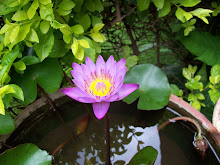
The Indigo plant,
INdigofera tinctoria is a native wild plant which grows throughout India.Although the dye obtained from it is blue, the flowers of Indigofera tinctoria are mauve or pink. Indigo has a long history as a dye. It was so valuable that it was called the Blue Gold.Newton named one of the colours of the spectrum after the colour of the dye.
Although many plants belong to the Indigofera family, it is the
Indigofera tinctoria which was used historically to obtain the blue dye. The leaves of the Indigo plant are boiled and allowed to ferment to obtain the dye.

The Indigo Revolt of 1858 in Bengal was considered by many historians as the precursor to the struggle for independence in India . The British East India Company, forced the farmers of Bengal to grow indigo instead of food crops , which led to mass revolt by the farmers. The famousBengali play , Neel Darpan is based on this revolt. In 1897, Indigo was grown in 7000 square kilometers . Even though they produced 19,000 tons of the precious dye for their foreign masters, the conditions the farmers lived in were abysmal. Everything changed suddenly, when the commercially viable synthetic indigo dye was synthesised in 1860.
Indigo has been used since pre historic times to dye cloth. The Greeks and Romans valued it as a luxury dye brought from India. In Japan, the summer Kimono Yukata, is dyed blue using Indigo, as it represents nature and the blue ocean. In America, the blue jeans were dyed with indigo. In India, indigo has been used to dye silk and cotton.

The Indigo plant is the host plant for the larvae of many butterflies.
In Indian alternative medicine, Indigo plant is used for alleviating pain.
The plant is known for its soil improving properties.
 TheNorfolk Island Pine Araucaria cookii seems to be pointing to the sky vehemently in front of Crawford Hall in Mysore which houses the administration block of the Mysore University.
TheNorfolk Island Pine Araucaria cookii seems to be pointing to the sky vehemently in front of Crawford Hall in Mysore which houses the administration block of the Mysore University.




















































